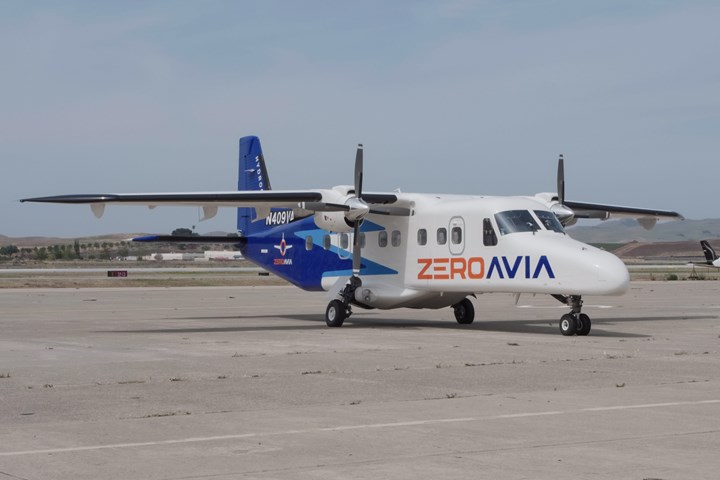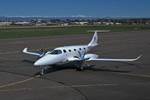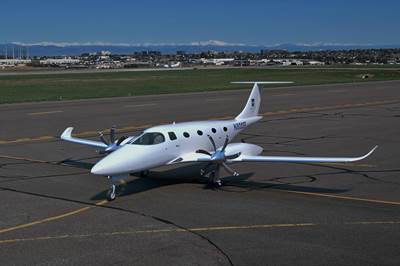ZeroAvia begins U.S. 19-seat hydrogen-electric aircraft testing, demonstration program
The company will expand its U.S. base to test new components for the ZA600 hydrogen-electric powertrains, with second Dornier 228 aircraft to be retrofitted and tested in the coming months.

Dornier 228 aircraft. Photo Credit: ZeroAvia
ZeroAvia (Hollister, Calif., U.S. and Kemble, U.K.) has received its second twin-engine 19-seat Dornier 228 aircraft at its headquarters in Hollister, Calif. The new U.S. initiative will take the system developed in the U.K. HyFlyer II project and integrate it into the same type of aircraft. According to the company, it will serve as the basis for testing new components and integrations, as well as a testbed for working with the Federal Aviation Administration (FAA) ahead of the ZA600 engine’s planned certification in 2024.
“This new project in California will enable us to use architectures from our Hyflyer II initiative, where we are working with the same aircraft, and apply those lessons as we further test and demonstrate the system across a number of different use cases,” Val Miftakhov, CEO and founder of ZeroAvia, says. “Ultimately, this will help us optimize our zero-emission powertrain design ahead of certification. This year, we will have two demonstration aircraft flying on two continents powered by our hydrogen-electric powertrains which will further help us secure partner and customer commitments across the worldwide aviation industry.”
ZeroAvia will work towards a hybrid engine configuration that incorporates both the company's hydrogen-electric powertrain and a conventional engine into the aircraft. The conversion is expected to take approximately three to four months to prepare the aircraft for test flights. After the engine is configured, it will enter into the flight testing and demonstration program, spanning passenger, cargo and industrial use cases with a number of to-be-announced partners.
Progressing the demonstrations of the two Dornier aircraft is said to be an important next step for ZeroAvia’s sequential R&D pathway to realizing transformational possibilities for aviation.
In addition to the launch of this program, ZeroAvia will be expanding its facility at Hollister to ensure adequate staff and resources to reach planned milestones. The company has added a new 15,000-square-foot hangar to its footprint at the airfield, enabling space for conducting engineering work on the aircraft and its HyperTruck test bed platform, as well as ample office space to support its growing operations.
“There is potential for Hollister Municipal Airport to become a hydrogen hub,” Renee Wells, executive director of the economic development corp. (EDC) San Benito County. “There will be significant demand and since California leads the world in adopting zero-emission vehicles, zero-emission flight infrastructure is the next natural frontier.”
Last fall, ZeroAvia conducted the first program ground test of its HyFlyer II program and successfully tested the flight-intent 600-kilowatt powertrain with its 15-ton HyperTruck mobile ground testing platform. The HyperTruck, developed based on heavy-duty military trucks, is sized to also support testing the company’s larger planned powertrain (ZA-2000, with shaft power over 1.8 megawatts) which can be used to test systems for 40-80 seat aircraft.
The HyFlyer II Project is co-funded by a £12.3 million ($16.3 million) grant through the UK Government’s ATI Programme. Progressing the demonstrations of the two Dornier aircraft is said to be an important next step for ZeroAvia’s sequential R&D pathway to realizing the transformational possibilities of moving from fossil fuels to zero-emission hydrogen as the primary energy source for commercial aviation.
In the last quarter of 2021, ZeroAvia secured partnerships and funding with major airlines Alaska Air Group and United Airlines to accelerate the development of its ZA2000 engine, the largest of ZeroAvia's powertrain platforms, capable of producing between 2,000 and 5,000 kilowatts. The company also recently announced its latest partnership with ZEV Station (see “ZeroAvia, ZEV Station gear up hydrogen refueling ecosystem at California airports”) where the two will collaborate to develop hydrogen refueling infrastructure at airports in California. ZeroAvia was also just named as a Bloomberg NEF Pioneer for its efforts to decarbonize aviation.
Related Content
Plant tour: Joby Aviation, Marina, Calif., U.S.
As the advanced air mobility market begins to take shape, market leader Joby Aviation works to industrialize composites manufacturing for its first-generation, composites-intensive, all-electric air taxi.
Read MoreThermoplastic composites welding advances for more sustainable airframes
Multiple demonstrators help various welding technologies approach TRL 6 in the quest for lighter weight, lower cost.
Read MoreMaterials & Processes: Fabrication methods
There are numerous methods for fabricating composite components. Selection of a method for a particular part, therefore, will depend on the materials, the part design and end-use or application. Here's a guide to selection.
Read MorePEEK vs. PEKK vs. PAEK and continuous compression molding
Suppliers of thermoplastics and carbon fiber chime in regarding PEEK vs. PEKK, and now PAEK, as well as in-situ consolidation — the supply chain for thermoplastic tape composites continues to evolve.
Read MoreRead Next
Bye Aerospace all-electric eFlyer 800 program advances
Production backlog reaches 135 purchase deposits and option agreements, approaching a total of 900 units in backlog.
Read MoreFrom the CW Archives: The tale of the thermoplastic cryotank
In 2006, guest columnist Bob Hartunian related the story of his efforts two decades prior, while at McDonnell Douglas, to develop a thermoplastic composite crytank for hydrogen storage. He learned a lot of lessons.
Read MoreComposites end markets: Energy (2024)
Composites are used widely in oil/gas, wind and other renewable energy applications. Despite market challenges, growth potential and innovation for composites continue.
Read More


























